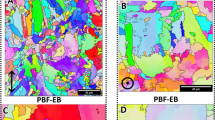Abstract
This manuscript presents a relatively simple simultaneously probabilistic and deterministic approach (SPADA) for the experiment organization. To exemplify the efficacy and flexibility of the method, we optimized the conditions for the synthesis of the Al2O3–SiC–AlN composite. Optimal synthesis parameters were predicted by evaluation of the impact of five variables (four related to mixture composition and one to annealing duration) on four different levels each. Compressive strength of the resulting composites was monitored as an output parameter for the material characterization. Such optimizations are arduous when done by full-factor experimental design (625 experiments necessary), whereas using SPADA design we accomplished the task by doing only 16 experiments. Maximum compressive strength of the composite was increased by 320% as compared to the starting experiment and by 45% as compared to the highest result produced by direct search; additionally, suggestions for the further improvements were outlined on the basis of calculated correlations.



Similar content being viewed by others
References
Jiang Zh, Feng P, Wang X, Zhang H, Liu Y (2018) Combustion synthesis and mechanical properties of MoSi2–ZrB2–SiC ceramics. J Ceram Soc Jpn 126(7):504–509
Guo Zh, Wu Sh, Hu Ch, Liu L, Fang L (2019) Preparation and dielectric properties of Ba4RFe0.5Nb9.5O30 (R¼ La, Nd, Eu, Gd) unfilled tungsten bronze ceramics. J Alloy Compd 773:470–481
Viard A, Fonblanc D, Lopez-Ferber D, Schmidt M, Lale A, Durif C et al (2018) Polymer derived Si–B–C–N ceramics: 30 years of research. Adv Eng Mater. https://doi.org/10.1002/adem.201800360
Tirupataiaha Ch, Kumara AS, Narendrudub T, Ram CCh, Sambasiva Raoa MV, Veeraiaha N et al (2019) Characterization, optical and luminescence features of cobalt ions in multicomponent PbO–Al2O3–TeO2–GeO2–SiO2 glass ceramics. Opt Mater 88:289–298
NIST/SEMATECH e-Handbook of Statistical Methods (2018) http://www.itl.nist.gov/div898/handbook/. 5th Dec 2018
Du C, Zhang X, Zhang Zh (2019) Quantitative analysis of ternary isomer mixtures of saccharide by terahertz time domain spectroscopy combined with chemometrics. Vib Spectrosc 100:64–70
Tarabeux J, Pateloup V, Michaud P, Chartier T (2018) Development of a numerical simulation model for predicting the curing of ceramic systems in the stereolithography process. J Eur Ceram Soc 38:4089–4098
Mao Z, Zhang ZD, Wei P, Zhang K (2017) Manufacturing feasibility and forming properties of Cu-4Sn in selective laser melting. Materials. https://doi.org/10.3390/ma10040333
Ruan X, Zhou Q, Shu L, Hu J, Cao L (2018) Accurate prediction of the weld bead characteristic in laser keyhole welding based on the stochastic Kriging model. Metals. https://doi.org/10.3390/met8070486
Hua Q, Liu Y, Zhang T, Genga G, Wang F (2019) Modeling the corrosion behavior of Ni–Cr–Mo–V high strength steel in the simulated deep-sea environments using design of experiment and artificial neural network. J Mater Sci Technol 35:168–175. https://doi.org/10.1016/j.jmst.2018.06.017
Mahamood RM, Akinlabi ET (2018) Processing parameters influence on microhardness in laser metal deposited titanium alloy using design if experiment. Mater Today: Proc 5:20437–20442
Read N, Wang W, Essa K, Attallah MM (2015) Selective laser melting of AlSi10Mg alloy: process optimization and mechanical properties development. Mater Des 65:417–424
Rahimia MH, Shayganmanesha M, Noorossanab R, Pazhuheian F (2019) Modelling and optimization of laser engraving qualitative characteristics of Al–SiC composite using response surface methodology and artificial neural networks. Opt Laser Technol 112:65–76
Moradi M, Moghadam MK (2019) High power diode laser surface hardening of AISI 4130; statistical modelling and optimization. Opt Laser Technol 111:554–570
Lewis RM, Torczon V, Trosset MW (2000) Direct search methods: then and now. J Comput Appl Math 124:191–207
Kolda TG, Lewis RM, Torczon V (2003) Optimization by direct search: new perspectives on some classical and modern methods. SIAM Rev Soc Ind Appl Math 45(3):385–482
Malyshev VP (1981) Veroiatnostno-determinirovannoe planirovanie eksperimenta (Simultaneously probabilistic and deterministic approach for the design of experiment). Nauka, Alma-Ata
Mukasyan AS, Shuck CE, Pauls JM, Manukyan KV, Moskovskikh DO, Rogachev AS (2018) The solid flame phenomenon: a novel perspective. Adv Eng Mater. https://doi.org/10.1002/adem.201701065
Rogachev AS, Mukasyan AS (2015) Combustion for material synthesis. CRC Press Taylor & Francis Group
Protodiakonov MM, Teder RI (1970) Metodika rasionalnogo planirovania eksperimenta (Rational design of experiment). Nauka, Moskow
Malyshev VP (1977) Matematicheskoe planirovanie metallurgicheskogo i himicheskogo eksperimenta (mathematical design of experiment for the application in chemistry and metallurgy). Nauka KazSSSR, Alma-Ata
Richardson JTE (2018) The use of Latin-square designs in educational and psychological research. Educ Res Rev 24:84–97
Viana Felipe A C (2016) A tutorial on Latin hypercube design of experiments. Qual Reliab Eng Int 32:1975–1985
Hoare A, Regan DG, Wilson DP (2008) Sampling and sensitivity analyses tools (SaSAT) for computational modelling. Theor Biol Med Model. https://doi.org/10.1186/1742-4682-5-4
Kobayashi R, Fukutomi Y, Takagi T (2016) Synthesis of AlN needles by nitridation of Al–Si melt. J Ceram Soc Jpn 124(10):1161–1163
Qin H, Li Y, Jiang P, Xue W, Tong Sh, Yan M (2017) In-situ synthesis of AlON reinforcing phases in resin bonded Al2O3 composite materials. J Alloy Compd 711:1–7
Xie X, Wang Y, Qi J, Wei N, Shi Q, Wang Sh et al (2015) Gas-phase and solid-state simultaneous mechanism for two-step carbothermal AlON formation. J Am Ceram Soc 98(6):1965–1973
Wang X, Sichen D, LiW Seetharaman S (2002) Kinetic studies of the oxidation of aluminum oxynitride. Metall Mater Trans B 33B:201–207
Chikami H, Fukushima J, Hayashi Y, Takizawa H (2018) Kinetics of microwave synthesis of AlN by carbothermal-reduction-nitridation at low temperature. J Am Ceram Soc 101:4905–4910
Martin AM (1933) The combustion of carbon. Carnegie Institute of Technology, Pittsburgh
Acknowledgement
The work was carried out with financial support from the Ministry of Education and Science of the Russian Federation in the framework of Increase Competitiveness Program of NUST « MISiS » (No. K4-2018-016), implemented by a governmental decree dated March 16, 2013, N 211.
Author information
Authors and Affiliations
Corresponding author
Additional information
Publisher's Note
Springer Nature remains neutral with regard to jurisdictional claims in published maps and institutional affiliations.
Rights and permissions
About this article
Cite this article
Yermekova, Z., Mironenko, A. Simultaneously probabilistic and deterministic approach (SPADA) for the materials design: methodology and experimental validation. J Mater Sci 54, 12381–12391 (2019). https://doi.org/10.1007/s10853-019-03815-y
Received:
Accepted:
Published:
Issue Date:
DOI: https://doi.org/10.1007/s10853-019-03815-y




